-

人教版高中历史必修3美术的辉煌教案2篇
画中的诸多图像反映了画家对于传统绘画因素的吸收。那个怀抱死去孩子的母亲图像,似乎是源自哀悼基督的圣母像传统;手持油灯的女人,使人联想起自由女神像的造型;那个高举双手仰天惊呼的形象,与戈雅画中爱国者就义的身姿不无相似之处;而那个张臂倒地的士兵形象,则似乎与意大利文艺复兴早期某些战争画中的形象,有着姻亲关系。由此可以看出,毕加索不仅是一位富于叛逆精神的大胆创新者,同时也是一位尊崇和精通传统的艺术家。教师须强调:现代主义美术是现代美术流派的总称,现代美术流派众多,多姿多彩,但它们也表现出许多共同的特征。在技法上,它们大都反对传统的写实主义,追求新奇,空间结构错乱,色彩配置随意,点线紊乱,缺乏透视可谓它们共有的特点。在创作主旨上,它们都主张强调自我,表现个人情感和内心世界。可以说,现代美术艺术再现了20世纪西方世界的精神状况。
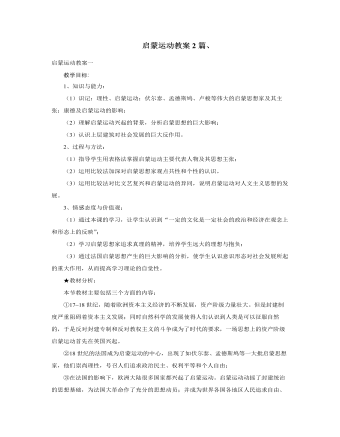
人教版高中历史必修3启蒙运动教案2篇
教学目标:1、知识与能力:(1)识记:理性、启蒙运动;伏尔泰、孟德斯鸠、卢梭等伟大的启蒙思想家及其主张;康德及启蒙运动的影响;(2)理解启蒙运动兴起的背景,分析启蒙思想的巨大影响;(3)认识上层建筑对社会发展的巨大反作用。2、过程与方法:(1)指导学生用表格法掌握启蒙运动主要代表人物及其思想主张;(2)运用比较法加深对启蒙思想家观点共性和个性的认识。(3)运用比较法对比文艺复兴和启蒙运动的异同,说明启蒙运动对人文主义思想的发展。3、情感态度与价值观:(1)通过本课的学习,让学生认识到“一定的文化是一定社会的政治和经济在观念上和形态上的反映”;(2)学习启蒙思想家追求真理的精神,培养学生远大的理想与抱负;(3)通过法国启蒙思想产生的巨大影响的分析,使学生认识意识形态对社会发展所起的重大作用,从而提高学习理论的自觉性。

人教版高中历史必修3文学的繁荣教案3篇
苏联文学的沿革,既反映了苏联社会的伟大思想性变革,又反映了苏联文坛活跃与混乱并存的局面,特别是其所具有强烈的意识形态色彩是苏联社会深层次变化的风向标。(2)20世纪的亚、非、拉美文学20世纪亚、非、拉美文学的繁荣伴随着民族民主运动的高涨,其主流都体现了反对殖民压迫、反对社会不公的爱国主义精神。出现了许多颇有影响的作家和作品。泰戈尔是印度近现代文学的光辉代表,为印度现代民族主义奠定了基础。其代表作《戈拉》塑造了爱国的印度民族主义知识分子形象。泰戈尔是首位获诺贝尔文学奖的东方作家。鲁迅是中国文学革命的巨匠,他的《呐喊》集,昭示着中国新文学时代的到来。哥伦比亚作家马尔克斯的《百年孤独》,描绘加勒比海沿岸小城百年孤独的原因及打破这种状态的途径。
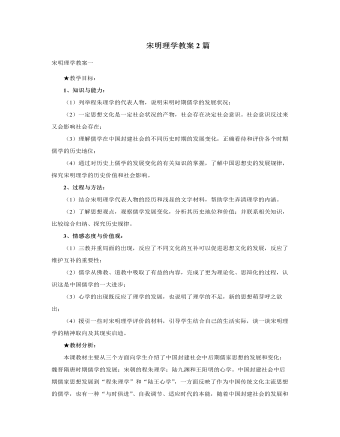
人教版高中历史必修3宋明理学教案2篇
二、程朱理学:1、宋代“理学”的产生:(1)含义:所谓“理学”,就是用“理学”一词来指明当时两宋时期所呈现出来的儒学。广义的理学,泛指以讨论天道问题为中心的整个哲学思潮,包括各种不同的学派;狭义的理学,专指程颢、程颐、朱熹为代表的,以“理”为最高范畴的学说,称为“程朱理学”。理学是北宋政治、社会、经济发展的理论表现,是中国古代哲学长期发展的结果,是批判佛、道学说的产物。他们把“理”或“天理”视作哲学的最高范畴,认为理无所不在,不生不灭,不仅是世界的本原,也是社会生活的最高准则。在穷理方法上,程颢“主静”,强调“正心诚意”;程颐“主敬”,强调“格物致知”。在人性论上,二程主张“去人欲,存天理”,并深入阐释这一观点使之更加系统化。二程学说的出现,标志着宋代“理学”思想体系的正式形成。【合作探究】宋代“理学”兴起的社会条件:
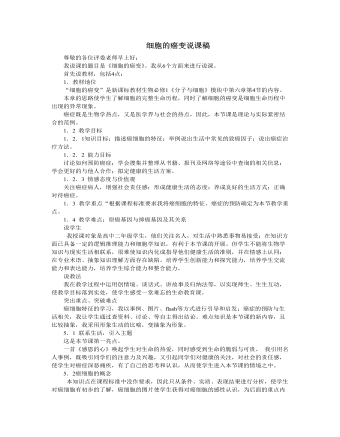
人教版高中生物必修1细胞的癌变说课稿
5.5癌症的预防作为本节最重要内容,且与生活息息相关,我采用老师引导、学生讨论总结的方法进行教学。从生活各方面总结出保健良方 ,既对知识有很好应用,又体现对生命的热爱。此时,本节课达到高潮,同学们意气风发,热烈讨论,实现本节课的教学目标。5.6 癌症的治疗通过讲述癌症治疗方法的副作用,激发学生探究生物学欲望,激励学生立志除癌。 在此,我选用一则关于一名癌症晚期病人运用心理疗法成功战胜癌症的故事,在于对不同层次的学生进行多方面启发教育,体现面向全体学生的课程理念。5.7 愉悦总结,及时反馈本节知识点零散,我将带领学生回忆浏览本节内容,使零散知识点系统化。在课堂反馈环节,我通过简单练习采用分组竞答的方式把握学生对知识的掌握程度,并给予表现突出的学生适当奖励,这是本节课第三个亮点。竞答既使课堂显得紧凑、集中,又有利于形成学生的竞争意识,还使得学生的知识得以巩固应用。

人教版高中生物必修1细胞的衰老与凋亡说课稿
4、最后从生物的寿命引入,探讨细胞的死亡。强调细胞死亡有两种形式。(1).细胞坏死,它是由某些外界因素造成细胞急速死亡,是一种被动性死亡;(2).细胞凋亡,这是一种由特定基因控制的主动性死亡。细胞坏死与细胞凋亡在形态学和生物化学上有着明显的区别。细胞凋亡有广泛的生物学意义,比如胚胎发育期手的发育如果没有细胞的调亡就不会有纤细的手指;如果没有正常的细胞调亡,蝌蚪的尾部就不会消失,它将永远不能变成青蛙……。正常的细胞调亡还肩负着维持各种组织器官固有体积和形态的功能;还会使机体内异常的细胞得到及时清除,去处潜在的隐患;例如癌症就是异常的细胞没有及时死亡的结果……。因此细胞的正常死亡是生物体的一种非常重要的调节机制,是机体平衡细胞增殖,调节机体细胞树木恒定的方式,是必不可少的生命过程。(15分钟)5、课堂小结,可以把课堂传授的知识尽快地转化为学生的素质;简单扼要的课堂小结,可使学生更深刻地理解政治理论在实际生活中的应用,并且逐渐地培养学生具有良好的个性。
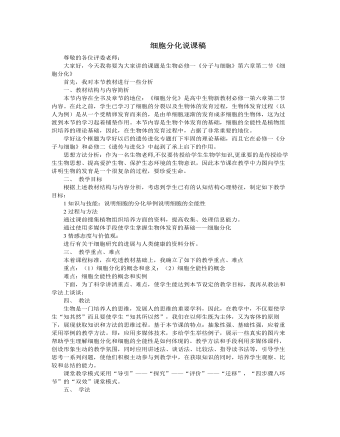
人教版高中生物必修1细胞分化说课稿
在讲述细胞分化的意义时,也可以用实例来解决,工厂的生产车间里不同的工人干着不同的工作,一件产品的产出需要这些工人才能创造出来,一个生物体就像一个车间一样,不同的细胞各司其职,相互合作。工人的分工是主管调解出来的,而不同细胞的出现就是细胞分化的结果,所以说,细胞的分化是生物体发育的基础。在讲到细胞全能性的时候,要多给学生举些关于细胞全能性的例子,如植物组织培养、克隆技术等等,让学生从实际的例子中真正的悟出细胞全能性的含义。此外,还要重视教材中的疑问,适当对题目进行引申,使它的作用更加突出,有利于学生对知识的串联、积累、加工,从而达到举一反三的效果。怎样来解释细胞的全能性呢?这主要以讲授法来解释了,细胞全能性的体现需要在组织或器官离体后才能体现出来,每个细胞都包含着生物体的全套遗传基因,通过基因选择性的表达,使离体的组织或器官通过分裂和分化逐渐发育成完整的植株。
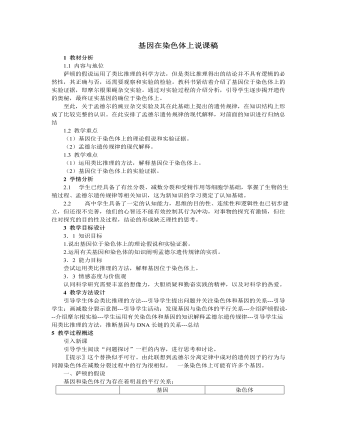
人教版高中生物必修2基因在染色体上说课稿
三、孟德尔遗传规律的现代解释①分离定律:在杂合体的细胞中,位于一对同源染色体上的等位基因,具有一定的独立性;在减数分裂形成配子的过程中,等位基因随同源染色体的分开而分离,独立地随配子遗传给后代。②自由组合定律:位于非同源染色体上的非等位基因的分离或组合是互不干扰的;在减数分裂过程中,同源染色体的等位基因彼此分离的同时,非同源染色体上的非等位基因自由组合。总结:再次强调孟德尔遗传定律的现代解释课堂练习:书本31页6、教学反思:本节课设置了一系列问题情境,层层设问,在学生答问、质疑、讨论过程中让学生建构新概念和新的知识体系,并通过教师及时掌握反馈信息,适时点拨、调节,让学生在推理判断中培养良好的思维习惯和对知识的迁移能力,而且通过留出一定的时间让学生提问,体现了以学生为主体的思想。
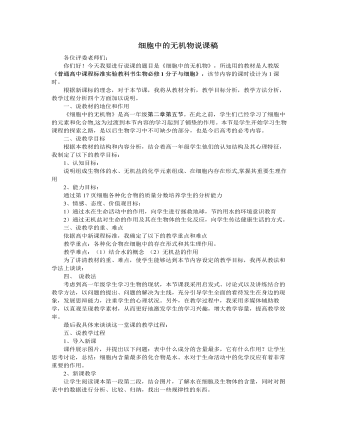
人教版高中生物必修1细胞中的无机物说课稿
为了加强学生的理解,让学生讨论以下问题。由师生共同总结。播放一个短时视频,让学生认识到水的重要性后,展示节水标识,说明由来。细胞中的无机盐这部分,我将展示图表,并列出问题:表中哪些成分属于无机盐?为什么要在运动员喝的饮料中添加无机盐?无机盐在细胞的生活中起什么作用?然后展示广告语,让学生思考和讨论以下问题,并得到答案。再阅读课本,验证自己的答案是否正确。关于无机盐的作用较难理解,通过列举人体生活与健康中的各种实例来加深感性认识,加强对理论知识的理解3、课堂小结,强化认识。(3—5分钟)课堂小结,可以把课堂传授的知识尽快地转化为学生的素质;简单扼要的课堂小结,可使学生更深刻地理解理论知识在实际生活中的应用,并且逐渐地培养学生具有良好的个性。4、板书设计我比较注重直观、系统的板书设计,还及时地体现教材中的知识点,以便于学生能够理解掌握。5、布置作业。
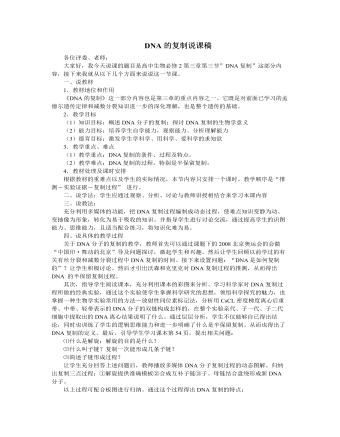
人教版高中生物必修2DNA的复制说课稿
设问:DNA复制后两个子代DNA分子与亲代DNA分子是否完全相同?为什么?通过设问,让学生进一步理解和巩固DNA复制的全过程。接下来让学生总结出DNA复制的四大基本条件:① 模板:开始解旋的DNA分子的两条单链;② 原料:是游离在核液中的脱氧核苷酸;③ 能量:是通过水解ATP提供;④ 酶:酶是指一个酶系统,不仅仅是指一种解旋酶。最后通过以上分析,总结出DNA复制的意义以及在生活中的应用:意义:DNA通过复制,使遗传信息从亲代传给子代,从而保证了物种的相对稳定性,保持了遗传信息的连续性,使物种得以延续。应用:目前DNA分子广泛应用于刑事案件侦破等方面:如:DNA分子是亲子鉴定的主要证据之一。把案犯在现场留下的毛发、血等进行分析作为破案的证据,与DNA有关。五、设计课堂练习:设计一题典型课堂练习:即有关半保留复制及计算的习题:
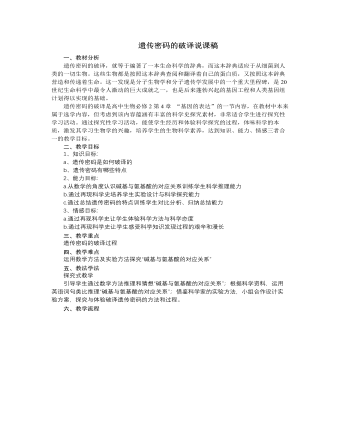
人教版高中生物必修2遗传密码的破译说课稿
3、遗传密码的特点 连续性、简并性、通用性5、课堂练习6、作业布置假如,我们利用(ACU)n核苷酸长链合成了含有苏氨酸的多肽,那么苏氨酸可能的密码子有哪些?如何运用实验方法确证苏氨酸的密码子究竟是什么?七、教学反思1、教材中丰富的科学史料,是我们在课堂上进行探究性学习活动的良好素材,教师要整理和运用好。千万不要低估学生的思维能力,当学生的思维能力被你想方设法激发出来的时候,你会发现他们的创造力是无穷的。2、探究性学习的目的并不仅仅是问题的解决,更重要的是在探究过程中体验和获取科学研究方法,培养合作与分享的精神以及实事求是的科学态度,锻炼思维能力,提高科学素养。3、学生是学习的主体,教师是引导者。我们要采取措施让学生积极主动地参与到学习活动中来,通过他们的思考、讨论、争辩、合作等活动来获取方法,建构知识。
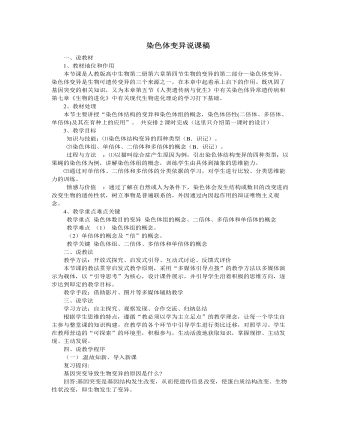
人教版高中生物必修2染色体变异说课稿
四、说教学程序(一).温故知新、导入新课复习提问:基因突变导致生物变异的原因是什么?回答:基因突变是基因结构发生改变,从而使遗传信息改变,使蛋白质结构改变、生物性状改变,即生物发生了变异。那么,基因是什么?它和染色体又有何关系?回答:基因是有遗传效应的DNA片断,染色体是DNA的载体,基因在染色体上呈线形排列。引出新知:对于一个生物体来说,正常情况下,其染色体的结构和数量都是稳定的。但在自然条件或人为因素的影响下,染色体的结构和数量均会发生改变,从而导致生物性状的改变,这就属于染色体变异。(二).把握重点、突破难点重点的把握:1、染色体结构的变异播放影片:猫叫综合征幼儿。让学生观察: 患儿哭声轻、音调高,很像猫叫。教师补充: 患儿的征状---两眼较低、耳位低下,存在着严重的智力障碍。阐述病因---染色体片段缺失
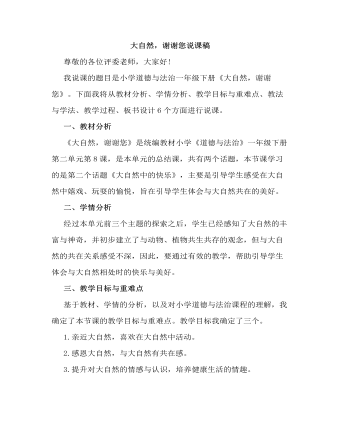
人教部编版道德与法制一年级下册大自然谢谢你
接着,教师引导学生与大自然对话,说一说:“大自然,我想对你说……”。设计意图:提升学生对大自然的情感与认识,感恩自然,喜欢在大自然中活动。活动三:阅读绘本,感恩自然学生阅读教材第30页到33页的绘本《大自然的语言》,教师引导学生说一说,大自然不仅给我们物质的馈赠、精神的馈赠,还给我们带来智慧的启迪。(板书:感恩)设计意图:再次感受与大自然的共在的情感。环节三:课堂小结,内化提升学生谈一谈学习本节课的收获,教师相机引导。设计意图:梳理总结,体验收获与成功的喜悦,内化提升学生的认识与情感。环节四:回归生活,拓展延伸课后,请同学们走进自然,拥抱自然。设计意图:将课堂所学延伸到学生的日常生活中,有利于落实行为实践。

人教版高中英语必修1Journey Down the Mekong说课稿
2. let the Ss complete the forms paragraph by paragraph. Purpose here is to help Ss to get the habit of reading a passage as a whole, and pay attention to the organization of the text, as a result the Ss will fully understand the whole passage.3. ask Ss to retell the passage with the help of the key words in the form.Since the Ss in the class are in different levels, so I let them to fill in the blank to understand the meaning of the words and phrases better. ( That’s all for the while-reading. Now let’s move to the fifth step.)Step V: Post-reading (10mins) ---DiscussionIn this part students are asked to discuss in groups and list Wang Kun’s and Wang Wei’s attitudes about the trip. After that, Ss are encouraged to express their attitudes with the whole class. Collect their answers and don’t forget to praise them even if their answers may not be perfect.In this activity, discussion provides a vivid and active learning environment for Ss to communicate in English with newly learned language items. (Finally it comes to the homework.)StepⅥ: Homework (1min)1. Ss are required to read the text again after class and figure out the meaning of some complex sentences.2. Do the exercises on P19; This can help Ss to consolidate what they’ve learnt and make preparation for the next lessonPart4. Blackboard design.(说板书设计)On the top, there is the title of this lesson. On the left, there are main ideas for each paragraph. On the right, there are some new words and expressions.Unit 3 Travel journalJourney down the MekongMain idea of each para.:Para1: deciding to take a great bike trip along the Mekong river.Para2: Different attitudes between Wang kun and Wang wei.

人教版高中英语必修4Body Language说课稿4篇
Textbook: Senior English for China (Book 4), by Liu Daoyi Time Allotment: 1 period (40 minutes)Date: March 20, 2014Teaching aids: blackboard, Multi-media, Power Point, chalk I. Text Analysis (教材分析)This unit is about body language, and the text selected in the reading part demonstrates the difference and similarity of body language in many parts of the world. Through learning this passage, students are required to raise their awareness of using body language in different parts of the world. As body language is closely related to our daily life, it is easy to arouse students’ interest in learning this text. Reading skills and speaking training are designed around the text.II. Teaching Objectives (教学目标)By the end of the lesson, students will be able to:1. Language Skill Objective(语言技能目标): develop reading ability (skimming and scanning)as well as speaking ability.2. Cultural Knowledge Objective(文化知识目标): know about the cultural differences of using body language.3. Affective Objective(情感目标): increase students’ awareness of using body language correctly in different cultures. III.Teaching Focuses and Difficulties(教学重点和难点)1. Teaching Focuses(教学重点): the difference and similarity of body language in many parts of the world.2. Teaching Difficulties(教学难点): develop students’ reading abilities of skimming and scanning and ask the students to show their opinions with fluent English.

人教版高中英语必修1Anne's best friend说课稿
Step 7 Language points 1.Vocabulary (1) go through (2) set down (3) a series of (4) on purpose (5) in order to (6)at dusk (7)entirely (8)face to face 2.Important sentences (1)…I’ve grown so crazy about everything to do with nature. (2)There was a time when … (3)I stayed awake on purpose until … (4)It was the first time … that I’d seen the night … (5)It’s no pleasure looking through … Purpose: 1.Master the required vocabulary and sentence structures. 2.Use them freely. Step 8 Consolidation 1.Find out the topic sentences 2.Retell the text according to the topic sentences Purpose: I want to know if my students understand the text. Step 9 Discussion Imagine you have to go into hiding like Anne and her family, what would you miss most? Giveyour reasons. Purpose: Train Ss’ oral English ability. Step 10 Homework Write an article on Friends. Purpose: 1. Improve the Ss’ writing ability. 2 Train the Ss’ ability of self—teaching and looking up information by themselves. Part 5 Blackboard design(说板书设计)Unit 1 Friendship Reading Anne’s Best Friend 1.Main idea of each paragraph: Para. 1 Anne made her diary her best friend. Para .2 Anne wrote her feelings in her diary. Para .3 Anne missed nature. Para.4 Anne saw the night face to face Para.5 Anne wanted to experience nature outdoors. 2.Listening: Exx.1 P3 3.Discussion: Exx.3 P3 Purpose: 1.Make Ss familiar with the passage 2.Make the design inductive, instructive and artistic.

人教版高中英语必修1English around the world说课稿
(3)v. 给:提出;展现,显现present sb. with sth. ; present sth. to sb. 把. . 交给;颁发;授予present sth. (for sth. )/present sth. to sb. e. g. Om his birthday, his friends presented him a collection of stamps. 在他生日时,他的朋友们送给他一套邮票作为礼物。The sword was presented by the family to the museum. 这家人把宝剑捐赠给了博物馆。The committee will present the final report to Parliament in June. 委员会将在六月向议会提交最后的报告。You need to present yourself better. 你需要更善于展现自己。It is essential that we present a united front. 至关重要的是我们要表现得更加团结。Step 4 ConsolidationT:Now that we have got a general idea of these words and phrases. Lets make up some sentences using them to master them. Suggested sentences:1. Your duties include typing letters and answering the telephone. 2. It is one of the greatest roles that she has played. 3. A large number of people have applied for the job. 4. The number of the panda is declining. 5. I'11 go there, even if I have to walk. 6. He came up to me to ask for a light. 7. The novel is about a family who can't communicate with each other. 8. He based his plan on interests of most people. 9. Why doesn't he make use of his singing talent?Step 5 Summary and homeworkT:Today we dealt with several new words and phrases. After class I hope that youcan read them again and again to keep them in mind. That's all for today. You aredismissed.

人教版高中英语必修1Nelson Mandela--A Modern Hero说课稿
In this step, give students a few minutes to read the passage . While they are reading, I will write some key words of the text on the blackboard. Then ask students to retell the passage according to the key words.By retelling, students can improve their ability of language organization and have an overall understanding of the article.Step 4 Group discussionIn this step, students will be divided into groups of 4 to discussion the following question: What qualities make a great person?After their discussion, invite a few groups to make a report to the class.This group discussion can practice students’ oral English and cultivate their abilities of cooperation and communication.Step 5. HomeworkLet students write a short passage to introduce a great person he or she admires.The homework can consolidate the knowledge the students have learned and cultivate their writing ability. Part 6 Blackboard Design(板书设计)That’s all my teaching procedures. Finally, I’d like to say sth about part 6 blackboard design. On the top is the title. On the left, there will be some new words and expressions. In the middle of the blackboard, I will write some useful sentence structures so that the students can know clearly what they’ve learned and then try to master the knowledge.OK. That’s all for my presentation. Thank you for your attention.

人教版高中英语必修2Computers说课稿3篇
一. 教材分析1. 本单元的中心话题是“计算机(Computers)”,内容涉及计算机的发展历史,计算机的应用等。本节课是该单元的第一课时,我将Warming up, Pre-reading and Comprehending这四部分整合为一节精读课。其中。Reading部分是题为WHO AM I?的文章,以第一人称的拟人手法介绍了计算机发长演变的历史和计算机在各个领域的应用,其主旨是表达计算机的发展变化之快以及在生活中用途之广。而Warming up部分以图片的形式展现了计算机的发展历程;Pre-reading中的问题和排序分别是为了预测语篇的内容和测试学生对计算机历史了解的情况;Comprehending则通过各项练习训练学生的阅读技能,从而加深对文章的理解。可见这几部分是一个有机的整体。2. 教学目标:1) 语言目标:重点词汇及短语:abacus, calculate, calculator, PC, laptop, PDA, robot, analytical, technological, universal, mathematical, artificial, intelligent, network, explore, in common, as a result.重点句子:a. My real father was Alan Turing, who in 1963 wrote a book to describe how computers could be made to work, and build a “universal machine” to solve any mathematical problem.

人教版高中英语必修2Cultural Relics说课稿2篇
Ⅲ. Analysis of the teaching material:The topic of this unit is cultural relics. Students are quite interested in topics about different cultures around the world. This is the second period of the whole unit. As a reading class, the passage mainly talks about the history of the amber room (how it was made, sent as a gift, lost and rebuilt).According to the new national curriculum, when teaching reading, much emphasis should be put on training the students’ reading skills.Ⅳ. Teaching objectives1. Language objectives:1) Students are required to master the key words and phrases occurred in the passage (e.g. amazing, decorate, belong, in return, less than etc.)2) Students are required to learn the attributive clause and acquire the sentence pattern.2. 1) Students are required to describe a certain thing by using the new sentence patterns.2) Students are required to master two kinds of reading skills—skimming and scanning, and learn to use them in their daily reading.3. 1) Students are required to know the history of the amber room.2) Students are required to appreciate cultural relics and understand the importance of protecting them.Ⅴ. Teaching important and difficult points1) the new words, phrases, and sentence pattern in the course of reading.2) Teaching difficult point: Help the students master two kinds of reading skills—skimmingand scanning and learn to apply them in daily use.Ⅵ. Teaching methods:Task-based method & Top-down model Ⅶ. Teaching aids: PPT, pictures, blackboard Ⅷ. Teaching procedure:

